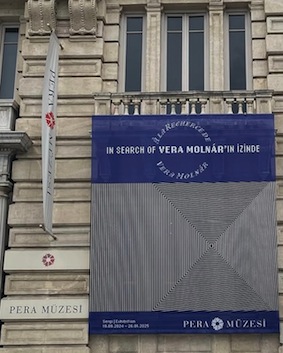


© Broich Digital Art Foundation
19 septembre 2024 - 26 janvier 2025
With:
Vera MOLNAR
and
Refik ANADOL
Arno BECK
Peter BEYLS
Snow Yunxue FU
Mario KLINGEMANN
Patrick LICHTY
Frieder NAKE
Casey REAS
Antoine SCHMITT
Erwin STELLER
Tamiko THIEL & /p
u2p050
Iskra VELITCHKOVA
aurèce vettier
Mark WILSON
Samuel YAN
Curators:
Richard CASTELLI and Zsófia MÁTÉ
In collaboration with BROICH Digital Art Foundation and Foundation for Art and Culture (Stiftung für Kunst und Kultur)
At Josef Broich's initiative, in collaboration wth Stiftung für Kunst und Kultur e.V. and the Broich Digital Art Foundation, the exhibition brought together the contemporary works of 16 artists inspired by Vera Molnár. Travaillant en vidéo ou en réalité augmentée à l'aide d'algorithmes, les artistes ont créé des œuvres qui rendent hommage au travail de l'artiste - en suivant ses méthodes ou en se référant à son univers visuel - après sa disparition en 2023 à l'âge de 99 ans. At Josef Broich’s initiative, a number of artists who have acknowledged Vera Molnar’s influence on their work have each created a piece in her honour.
The history of computing and its applications is marked by female figures. Here are three examples: In 1842, Ada Lovelace wrote the first software for Charles Babbage’s analytical machine. In 1941, Hollywood star Hedy Lamarr and composer George Antheil designed a torpedo guidance system called the “frequency-hopping spread spectrum (FHSS)”, which would later be used for mobile communications, GPS and, indirectly, WiFi. In the 1960s, another female figure, Margaret Hamilton, was crucial in developing the software for NASA’s Apollo missions.
It was around the same time that Vera Molnar, who had already been developing a way of working for ten years that she called the ”Imaginary Machine”, discovered the association of the computer with a screen. As she said in 2017: “When I saw a screen for the first time, it was like my arrival in Paris or the end of the war, there are days like that, that you never forget. I had the impression that it was invented for me. That other people didn’t know what to do with it. It was made for me. I was a little right.”
© Richard Castelli
Curator
